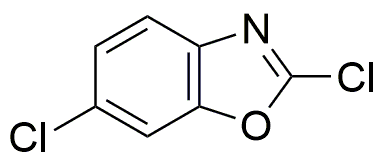2,6-Dichlorobenzoxazole is widely utilized in research focused on:
- Pharmaceutical Development: This compound serves as a key intermediate in the synthesis of various pharmaceuticals, particularly in the development of anti-inflammatory and antimicrobial agents.
- Analytical Chemistry: It is used as a reagent in analytical methods to detect and quantify certain biological molecules, aiding researchers in drug formulation and quality control.
- Material Science: The compound is employed in the production of specialty polymers and coatings, enhancing material properties such as thermal stability and chemical resistance.
- Agricultural Chemistry: It finds applications in the formulation of agrochemicals, contributing to the development of effective herbicides and fungicides that improve crop yields.
- Environmental Research: Researchers utilize it to study the degradation pathways of chlorinated compounds, helping to assess environmental impact and develop remediation strategies.
Informations générales
Propriétés
Sécurité et réglementation
Applications
2,6-Dichlorobenzoxazole is widely utilized in research focused on:
- Pharmaceutical Development: This compound serves as a key intermediate in the synthesis of various pharmaceuticals, particularly in the development of anti-inflammatory and antimicrobial agents.
- Analytical Chemistry: It is used as a reagent in analytical methods to detect and quantify certain biological molecules, aiding researchers in drug formulation and quality control.
- Material Science: The compound is employed in the production of specialty polymers and coatings, enhancing material properties such as thermal stability and chemical resistance.
- Agricultural Chemistry: It finds applications in the formulation of agrochemicals, contributing to the development of effective herbicides and fungicides that improve crop yields.
- Environmental Research: Researchers utilize it to study the degradation pathways of chlorinated compounds, helping to assess environmental impact and develop remediation strategies.
Documents
Fiches de données de sécurité (FDS)
La FDS fournit des informations de sécurité complètes sur la manipulation, le stockage et l’élimination du produit.
Spécifications du produit (PS)
Le PS fournit une description complète des propriétés du produit, notamment sa composition chimique, son état physique, sa pureté et les exigences de stockage. Il détaille également les plages de qualité acceptables et les applications prévues du produit.
Certificats d'analyse (COA)
Recherchez des certificats d'analyse (COA) en saisissant le numéro de lot du produit. Les numéros de lot et de lot se trouvent sur l'étiquette d'un produit, après les mots « Lot » ou « Lot de fabrication ».
Numéro de catalogue
Numéro de lot/série
Certificats d'origine (COO)
Ce certificat d'exploitation confirme le pays dans lequel le produit a été fabriqué, et détaille également les matériaux et composants utilisés et s'il est issu de sources naturelles, synthétiques ou autres sources spécifiques. Ce certificat peut être requis pour les douanes, le commerce et la conformité réglementaire.
Numéro de catalogue
Numéro de lot/série
Fiches de données de sécurité (FDS)
La FDS fournit des informations de sécurité complètes sur la manipulation, le stockage et l’élimination du produit.
DownloadSpécifications du produit (PS)
Le PS fournit une description complète des propriétés du produit, notamment sa composition chimique, son état physique, sa pureté et les exigences de stockage. Il détaille également les plages de qualité acceptables et les applications prévues du produit.
DownloadCertificats d'analyse (COA)
Recherchez des certificats d'analyse (COA) en saisissant le numéro de lot du produit. Les numéros de lot et de lot se trouvent sur l'étiquette d'un produit, après les mots « Lot » ou « Lot de fabrication ».
Numéro de catalogue
Numéro de lot/série
Certificats d'origine (COO)
Ce certificat d'exploitation confirme le pays dans lequel le produit a été fabriqué, et détaille également les matériaux et composants utilisés et s'il est issu de sources naturelles, synthétiques ou autres sources spécifiques. Ce certificat peut être requis pour les douanes, le commerce et la conformité réglementaire.

